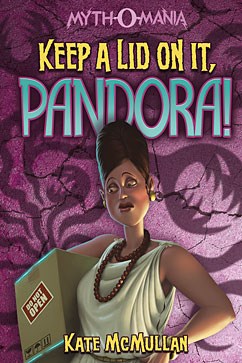Title of the work
Country of the First Edition
Country/countries of popularity
Original Language
First Edition Date
First Edition Details
Kate McMullan, Myth-O-Mania: Keep a Lid on It, Pandora! Mankato, Minn.: Stone Arch Books, Capstone, 2012, 192 pp.
ISBN
Genre
Humor
Mythological fiction
Novels
Teen fiction*
Target Audience
Crossover (Teens grades 4–8)
Cover

Courtesy of Capstone Global Library Ltd., publisher.
Author of the Entry:
Allison Rosenblum, Bar-Ilan University, allie.rose89@gmail.com
Peer-reviewer of the Entry:
Lisa Maurice, Bar-Ilan University, lisa.maurice@biu.ac.il
Elżbieta Olechowska, University of Warsaw, elzbieta.olechowska@gmail.com

Bob Lentz (Illustrator)
Lentz graduated from Minneapolis College of Art and Design before beginning a 5-year career working on a newspaper in Rochester, MN and then becoming a graphic designer at Capstone Press, specifically in their Graphic Library brand. He worked on the first 32 titles, including the Graphic Science sub-series. He became Senior Designer and stayed with Capstone for four years before becoming Art Director for Stone Arch Books. He developed several of Capstone’s proprietary brands, including Hello Genius, Capstone’s first venture into baby board books, DC Super-Pets!, and Goodnight Baseball.
Source:
Online interview (accessed: June 27, 2018).
Bio prepared by Allison Rosenblum, Bar-Ilan University, allie.rose89@gmail.com

Photo courtesy of Kate McMullan.
Kate McMullan
, b. 1947
(Author)
Grew up in St. Louis, Missouri, but now lives in Sag Harbor, New York. McMullan began her career as a teacher after which she studied Early Childhood Education. She worked as a teacher in Los Angeles and an American Air Force base in Germany. She is married to and works with the illustrator Jim McMullan.
She has commented: "As soon as I could, I began reading my way through the Children’s Room shelves at our local public library in St. Louis, Missouri. I carried my books home, settled in with a cat or dog or my guinea pigs on my lap, and read for hours. My favorites were Greek myths, Nancy Drew mysteries, Pippi Longstocking, and animal stories, but only if the animals didn’t die. I also read Little Women (it was sad but acceptable if people died) and The Borrowers, about tiny people who lived behind the walls of houses. I loved comic books, too, and Mad Magazine. When asked what I wanted to be when I grew up, I answered, "A reader."
"After college, I taught fourth grade in an inner-city Los Angeles school and on an American Air Force base in Germany. Every day after lunch I read to my students, and in time I started to wonder if I could write books like the ones I read to my class. I tried, but after a day of teaching, I had little energy left for writing, so I moved to New York City, where I’d heard writers lived, and took a job in publishing, which was less tiring than teaching."
"And I kept writing – stories about Fluffy, the Classroom Guinea Pig (who will never die), a Greek Mythology series, books set in a medieval school for dragon-slaying, and picture books with art by my favorite illustrator, Jim McMullan." (source, see here, accessed: February 21, 2019).
Since she started writing, McMulland has published over 100 children’s books. Her book Pearl and Wagner: One Funny Day was a Geisel Honor Book, and her book I Stink! was a Boston Globe-Horn Book Award Honor Book.
Sources:
Official website (accessed: June 26, 2018).
Profile at penguinrandomhouse.com (accessed: June 26, 2018).
Profile at harpercollins.com (accessed: June 26, 2018).
Profile at amazon.com (accessed: February 21, 2019).
Bio prepared by Allison Rosenblum, Bar-Ilan University, allie.rose89@gmail.com and Tikva Schein, Bar-Ilan University, tikva.blaukopf@gmail.com
Questionnaire
1. What drew you to writing / working with Classical Antiquity and what challenges did you face in selecting, representing, or adapting particular myths or stories?
I have always loved the ancient Greek myths, even as a child. I write books for kids, and thought it would be fun to retell some of the myths with a bit of twist, and what I came up with was using Hades as my narrator. In some versions of the myths, Hades is Zeus's older brother, and I thought having his little brother be the ruler of the Universe would annoy Hades quite a bit, so I figured that would make his retelling funny and engaging for kids.
2. Why do you think classical / ancient myths, history, and literature continue to resonate with young audiences?
I believe it's because the dieties are, for the most part, depicted as very human, with great character flaws as well as the capacity to do great good. I think humans connect with these gods and goddesses because of they show different aspects of the human heart.
3. Do you have a background in classical education (Latin or Greek at school or classes at the University?)
NO.
4. What sources are you using? Scholarly work? Wikipedia? Are there any books that made an impact on you in this respect?
I used the D'Aulaires' Book of Greek Myths and Theoi.com as well as various other sources. Although I wasn't telling the myths in the traditional way, I did try to stay faithful to the way each myth is usually presented.
Prepared by Allison Rosenblum, Bar-Ilan University, allie.rose89@gmail.com

Photo courtesy of Denis Zilber.
Denis Zilber
, b. 1962
(Illustrator)
Denis has a diploma in Advanced Character Animation Studies and has won the following awards for his freelance work as illustrator and character designer: “CG Choice” award of CGSociety.org (3 times), Animation Mentor Showcase 2009, Frontpage Exellence award of 3DTotal.com (twice). He has publications in Expose 4 – Finest digital art in the known universe by Ballistic Publishing, Australia, as well as in 2D Artist magazine and CGWorld magazine.
Source:
Official website (accessed: May 29, 2018).
Bio prepared by Allison Rosenblum, Bar-Ilan University, allie.rose89@gmail.com
Summary
Keep a Lid on it, Pandora! Tells the story of Pandora’s box and Prometheus stealing fire with a contemporary twist, narrated by Hades, and is part of a series of Greek myths told from Hades’ point of view.
Hades claims that Zeus edited all the original myths in order to make himself look more powerful. He goes on to give a different explanation for the myth of Pandora’s Vase, specifically that he and Zeus had made a bet on whether Pandora would open it or not. Since Zeus bet that she would, he finds ways to trick her into opening the box. Pandora’s story starts with Prometheus’ creation of men and stealing fire from the gods to give to them. In punishment, Zeus creates Pandora. Each of the gods give Pandora a gift. Zeus gives her extreme curiosity, and then gives her the box, which he eventually tricks her into opening.
The author includes a glossary, discussion questions, and a few writing prompts.
Analysis
Keep a Lid on it, Pandora! explains the story of Prometheus and Pandora’s vase in a unique way and using very simple language (refers to mankind as “guys”). Hades, as the narrator, claims that the original tale is extremely one-sided, and he endeavours to give a different side to Pandora’s story. The book does a good job of explaining the background of the animosity between Zeus and Prometheus, as well as humanizing the characters and making them more relatable. The story ends with Hades getting ready to tell the “truth” about another story from Greek mythology that has been misrepresented.
Addenda
Cover, map, and interior design by Bob Lentz.


